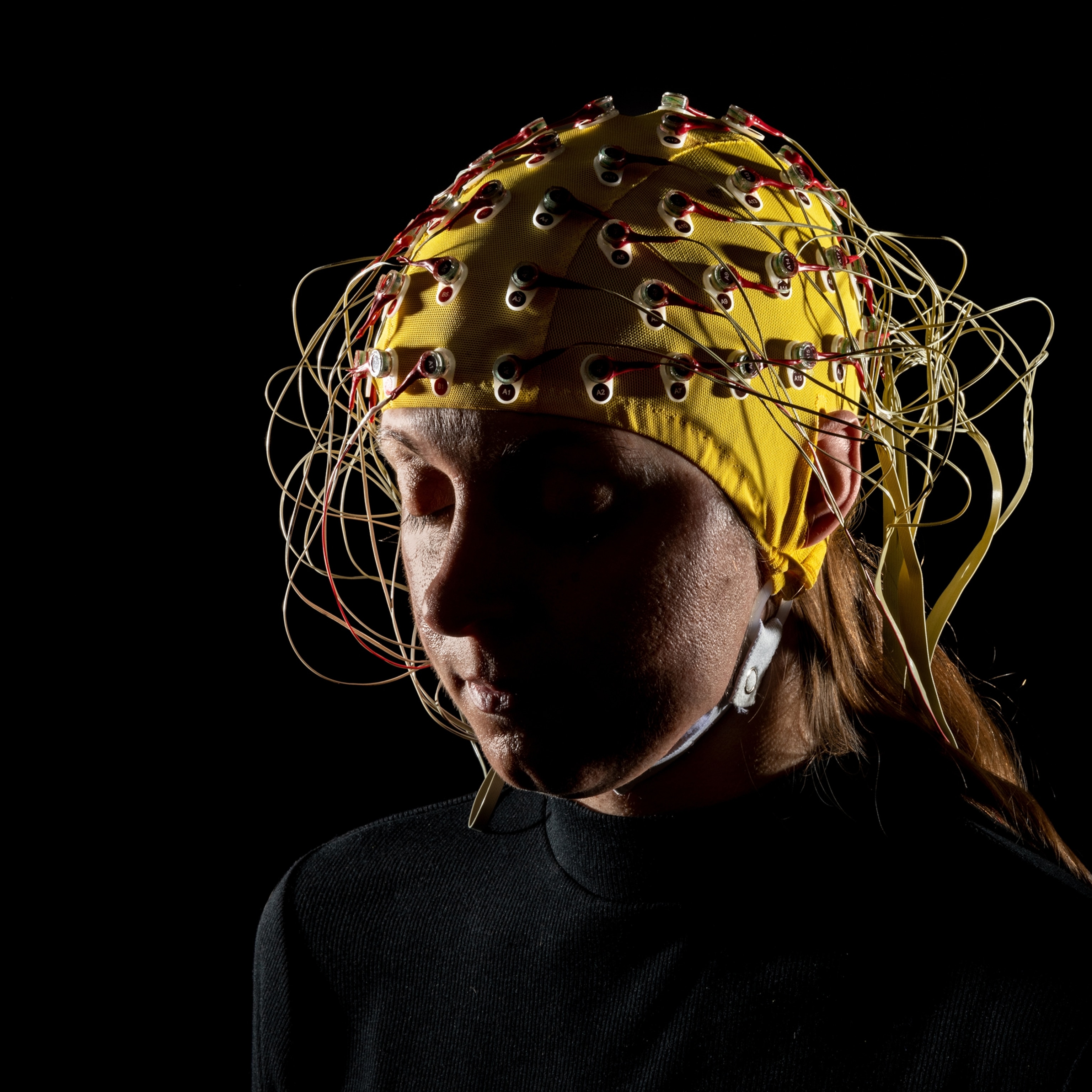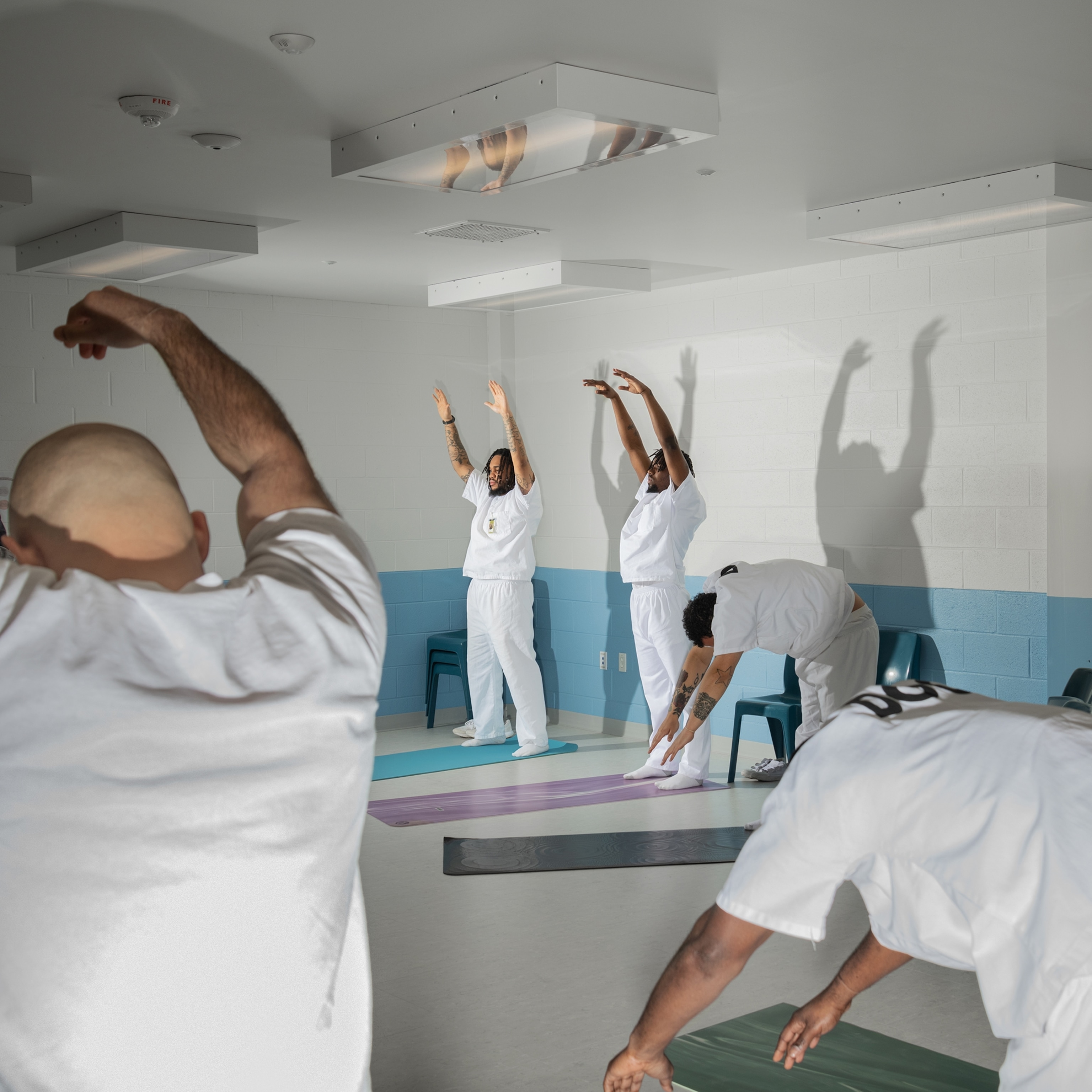Does meditation actually work? Here’s what the science says.
Research is finally catching up to the idea that meditation—which has been practiced for millennia—also provides many health benefits, including managing stress and anxiety.

Growing up in India, I would spend summer breaks visiting my grandparents in Kolkata. Each afternoon, my grandmother settled down on a floor mat, facing the family’s worship room, where stone idols of Hindu deities sat on little wooden thrones. For half an hour, she would sit still, her eyes closed, fingers rolling her prayer beads, chanting Krishna’s name in a whisper.
It’s impossible to know, objectively, whether those meditation sessions helped my grandmother achieve some sort of communion with a higher power, but a growing body of scientific evidence suggests she benefited from it in multiple ways. The practice was likely an effective approach for her to manage her stress. It may have also helped slow down aging-related cognitive decline. It also probably enhanced her ability to cope with pain.
Defined most broadly as the exercise of focusing one’s attention on the current moment, meditation in some form has been practiced for millennia by religious traditions around the world—most rooted in a quest for spiritual enlightenment.
Today, the popularity of meditation has grown in parallel with awareness about the importance of mental health and stress relief. Many U.S. schools now have programs that teach meditation to students, while dozens of meditation apps such as Headspace and Calm offer people the option of using their smartphones—otherwise a source of distraction—to immerse themselves in sessions guided by instructors, with calming music playing in the background, at their own convenience.
(Quieting your mind to meditate can be hard. Here’s how sound can help.)

“Twenty years ago, when I used to tell people I meditated, they would think I was in a cult or something,” notes Kathryn Devaney, a neuroscientist who researches meditation at the University of California, Berkeley. “Then something changed around six years or so. Now when I talk to people about meditation, the response I get often is ‘Oh, I know I should be doing that.’”
What these modern meditation enthusiasts are learning is that there really are health benefits from doing breathing exercises for a few minutes a day—and research has begun to confirm it.
Meditation relieves stress and anxiety
Sara Lazar, a psychologist at Harvard University, and her colleagues have conducted studies that illuminate how meditation reduces anxiety, which has very similar symptoms to stress.
In one study, researchers compared stress-reduction programs: one mindfulness-based, in which 42 volunteers learned awareness meditation and yoga practices for eight weeks, the other exercise-based, during which 25 volunteers performed light aerobic exercises.
The researchers put both groups through a fear-conditioning task in which an anxiety-inducing stimulus is repeatedly presented to the patient until it no longer triggers anxiety. The volunteers were shown an image of a lamp that glowed blue, red, or yellow, receiving a mild electric shock with two of the colors. Later, the same image was presented to them without the shock.
Lazar and her colleagues found those who received the mindfulness-based stress-reduction training were better able to shed their fearful response to the shock-associated lamp colors. From brain scans of the volunteers, the researchers concluded that the mindfulness training had changed how their brains processed their initial fearful memories and increased their ability to recall that the stimulus was no longer threatening.
(You’ve heard of forest bathing. Now try forest therapy.)
Learn more about stress and how to manage it
Meditation reduces pain
The benefits of meditation may extend beyond stress and anxiety reduction. Fadel Zeidan, a neuroscientist at the University of California, San Diego, has been studying how mindfulness can help reduce pain.
In a recent study, Zeidan and his colleagues assigned volunteers to a group that went through mindfulness training and a control group that did not. First, the volunteers rated their pain after a hot probe was pressed to the back of their leg for 10 to 14 seconds (they could move their leg away at any time). Then they went through the same process again, but this time the mindfulness group was asked to meditate, while those in the control group listened to an audio recording of The Natural History and Antiquities of Selborne, a classic of 18th-century nature writing. The researchers also took functional MRI scans of the volunteers’ brains.


Volunteers who meditated reported feeling less pain. “We see a 33 percent drop in pain intensity and unpleasantness during meditation, while the pain levels in the control group actually go up,” Zeidan says.
Why does meditation provide relief? Zeidan says the researchers were able to find an answer from analyzing the functional MRI scans of the meditators, which show reduced activation in neural networks that are responsible for self-awareness. The greatest decrease in activation is seen in the medial prefrontal cortex—a part of the “self network” that plays a prominent role in self-reflection and valuing oneself.
“During the meditation, the self-value is deactivating,” Zeidan says. “And the more it goes down, the greater the analgesia, the greater the pain relief.” Pain signals are still being received by the brain, but “they are not going into the brain networks that are saying, This is my pain,” he explains. In essence, mindfulness appears to help detach the self from the suffering.
Meditation can help you stay calm
Last November I traveled to a prison—a place presumably rife with stress—to watch meditation teachers from the International Association for Human Values lead a session of Sudarshan Kriya Yoga (SKY), a meditation technique using rhythmic breathing to focus the mind. Like other forms of meditation, SKY promises to give practitioners the ability to stay calm in stressful situations.
Some of the people at the session I attended had already received training in the technique and were striving to apply it to their daily lives. (The authorities at the Howard R. Young Correctional Institution in Wilmington, Delaware, allowed me to interview them on condition that I not use last names.)

I spoke to Jorge, a short man in his late 20s with a wispy beard and bright eyes, who was sent to the prison on a first-degree-assault charge in 2016. He told me he was born in Puerto Rico and moved to mainland America when he was five. Because he wasn’t fluent in English, his peers laughed at him in school. “I didn’t know how to respond,” he told me. So he got into fights.
Jorge had heard about meditation years earlier when he was in a wrestling club. Somebody he knew there would meditate before matches and didn’t seem to get agitated, even when losing. “I used to wonder, how come I’m so mad and he’s always calm?” Jorge said.
The question had been partly answered, he said, by what he had been learning in the prison meditation program. And he’d begun applying that to his life. “When I feel like I’m getting flustered or angry,” he says, “I just breathe.”
(How to relieve stress at the world’s beautiful Zen gardens.)
Brian Finke has photographed multiple features for National Geographic, including the science of taste and The Carnivore’s Dilemma. His work has been published in several books and featured in museum collections around the world. He manages stress by cycling around New York City.
A version of this story appears in the June 2024 issue of National Geographic magazine.
Related Topics
You May Also Like
Go Further
Animals
- Elephants may call each other by name, a rare trait in natureElephants may call each other by name, a rare trait in nature
- Are 'giant, flying' joro spiders really taking over the U.S.?Are 'giant, flying' joro spiders really taking over the U.S.?
- This invisible killer takes out 3.5 billion U.S. birds a yearThis invisible killer takes out 3.5 billion U.S. birds a year
- Charlotte, the 'virgin birth' stingray, has a diseaseCharlotte, the 'virgin birth' stingray, has a disease
- See how billions of cicadas are taking over the U.S. this summerSee how billions of cicadas are taking over the U.S. this summer
Environment
- How scientists link specific weather events and climate changeHow scientists link specific weather events and climate change
- Extreme heat is ahead—and you’ll feel every degree of itExtreme heat is ahead—and you’ll feel every degree of it
- Ready to give up fast fashion? Give 'slow fashion' a try.Ready to give up fast fashion? Give 'slow fashion' a try.
- Exploring south-central Colorado’s backcountry
- Paid Content
Exploring south-central Colorado’s backcountry - 2024 hurricane season forecasted to be record-breaking year2024 hurricane season forecasted to be record-breaking year
- Connecting a new generation with South Africa’s iconic species
- Paid Content
Connecting a new generation with South Africa’s iconic species
History & Culture
- How the rainbow flag became a symbol of the LGBTQIA+ communityHow the rainbow flag became a symbol of the LGBTQIA+ community
- No women allowed: These 5 destinations are men-onlyNo women allowed: These 5 destinations are men-only
- The harrowing true story of the photo that defined D-DayThe harrowing true story of the photo that defined D-Day
- The forgotten history of New York’s first electric taxi fleet—in the 1800sThe forgotten history of New York’s first electric taxi fleet—in the 1800s
- Your khaki pants have a history that may surprise youYour khaki pants have a history that may surprise you
Science
- This is the biggest health challenge women face in their 50sThis is the biggest health challenge women face in their 50s
- How scientists link specific weather events and climate changeHow scientists link specific weather events and climate change
- Why health advocates are concerned about a chemical in your decafWhy health advocates are concerned about a chemical in your decaf
- Is decaf healthier than regular coffee? Here’s how they compare.Is decaf healthier than regular coffee? Here’s how they compare.
- Why doctors can't agree that more breast screenings save livesWhy doctors can't agree that more breast screenings save lives
Travel
- Is this small Baltic city the arts and culture capital of 2024?Is this small Baltic city the arts and culture capital of 2024?
- Come for the Euros, stay for food in Germany’s Rheingau regionCome for the Euros, stay for food in Germany’s Rheingau region
- 5 unique ways to discover Jersey’s coastline
- Paid Content
5 unique ways to discover Jersey’s coastline - 9 of the world's most beautiful lakes—and what to do there9 of the world's most beautiful lakes—and what to do there
- 5 of the best places to eat in Trastevere, Rome
- Paid Content
5 of the best places to eat in Trastevere, Rome







